A Conversation with Bruce Duffie
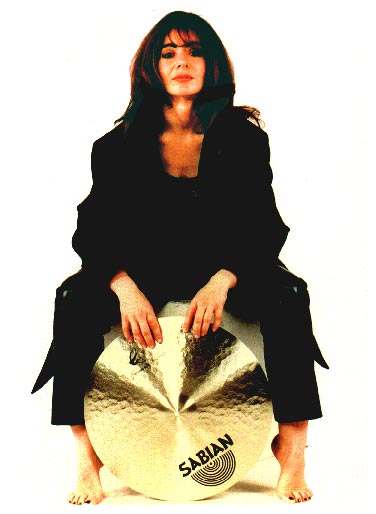

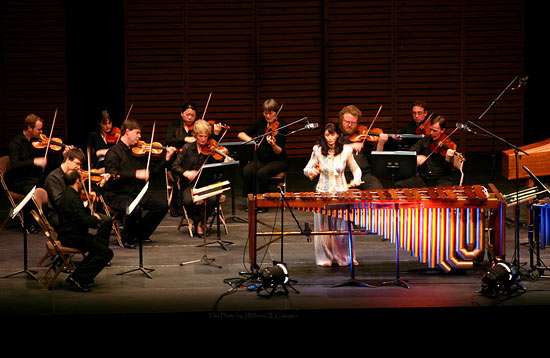
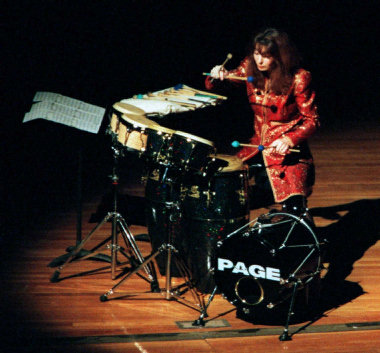 EG: It’s a good
question, and this is something
that I find I have to explore a lot with the equipment. For
example, I may just have one tom-tom and I’ll remove the head
completely. Then I’ll pop it on and just start from the head
being really, really slack. I’ll work my way up and just take
my time to know what things feel like — what kind of experiences I’m
having. But all the time, I know the type of sound that I’m
after, whether
it’s reverberant sound or a kind of dead, dull sound,
whether it’s a bright sound or a short, sharp
sound, whatever. Just little things like that and I
just work my way through the drum to really, really
get to know the real subtleties. Obviously someone
has to say what’s happening with the instrument, or if there are any
overtones or harmonics, but generally I
just like to work it out myself.
EG: It’s a good
question, and this is something
that I find I have to explore a lot with the equipment. For
example, I may just have one tom-tom and I’ll remove the head
completely. Then I’ll pop it on and just start from the head
being really, really slack. I’ll work my way up and just take
my time to know what things feel like — what kind of experiences I’m
having. But all the time, I know the type of sound that I’m
after, whether
it’s reverberant sound or a kind of dead, dull sound,
whether it’s a bright sound or a short, sharp
sound, whatever. Just little things like that and I
just work my way through the drum to really, really
get to know the real subtleties. Obviously someone
has to say what’s happening with the instrument, or if there are any
overtones or harmonics, but generally I
just like to work it out myself.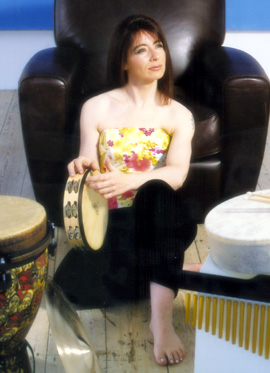 EG: [Laughs] Well,
you know, I involve a lot of
improvisation within the notated music I play and I find that I have to
have this kind of freedom. I don’t know
why; it’s just the way I am. Basically I learn the piece as I
see it on the page, but that is done away from the instrument. I
don’t mean that I
simply have the music memorized, but I just mean I can quickly
look at the music and know what it’s about. Once
I have this almost visual memory, then, I go to
my
instrument and really I don’t have to worry about the actual
mechanics of playing because I’ve been thinking about the music first
of all, and working out the technical difficulties within my
mind. If you do it this way, it means that everything you
think about is always perfect! So immediately
you have positive thoughts, and then when I get to the
instrument, I’m concentrating on sound, on color, on effects — lots of
different things like how I want to interpret the music and how I want
the instrument to speak.
EG: [Laughs] Well,
you know, I involve a lot of
improvisation within the notated music I play and I find that I have to
have this kind of freedom. I don’t know
why; it’s just the way I am. Basically I learn the piece as I
see it on the page, but that is done away from the instrument. I
don’t mean that I
simply have the music memorized, but I just mean I can quickly
look at the music and know what it’s about. Once
I have this almost visual memory, then, I go to
my
instrument and really I don’t have to worry about the actual
mechanics of playing because I’ve been thinking about the music first
of all, and working out the technical difficulties within my
mind. If you do it this way, it means that everything you
think about is always perfect! So immediately
you have positive thoughts, and then when I get to the
instrument, I’m concentrating on sound, on color, on effects — lots of
different things like how I want to interpret the music and how I want
the instrument to speak.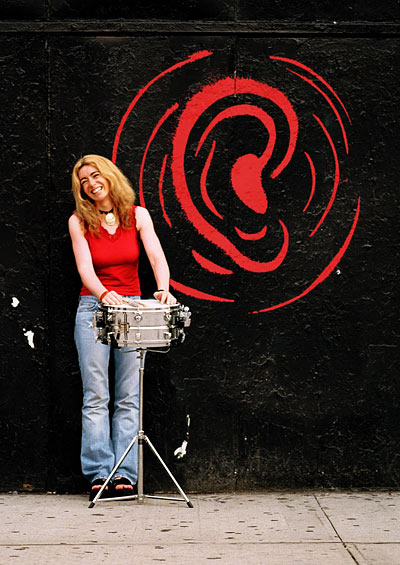 BD: Would it be
frustrating for you, then, to have a
concerto for snare drum?
BD: Would it be
frustrating for you, then, to have a
concerto for snare drum?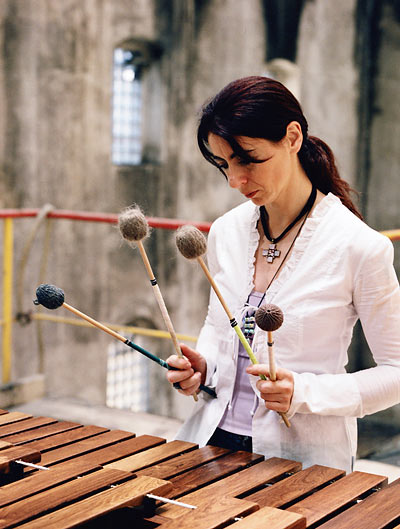 BD: Such as the
gamelan?
BD: Such as the
gamelan?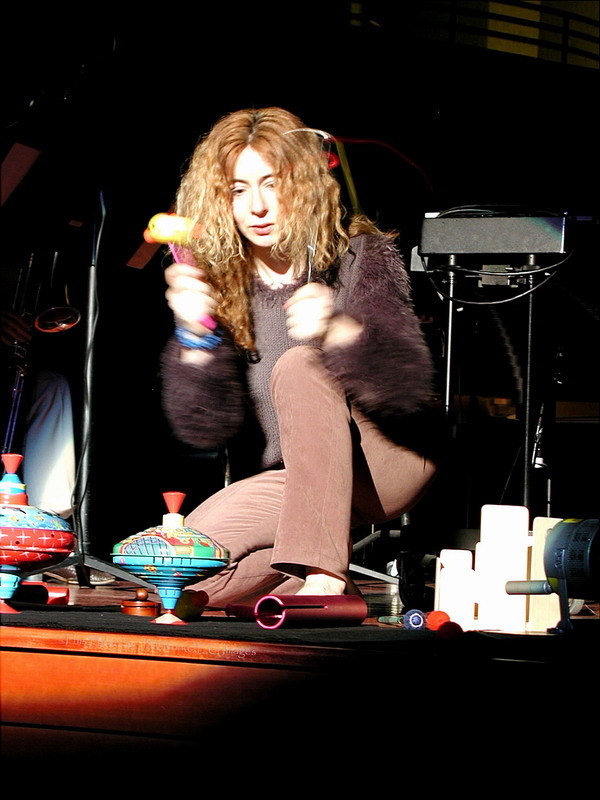 EG: Again, it’s
something I don’t
really think about. Strangely enough, when I look at myself on a
video or a TV, then I think to myself,
“Gosh, do I really look like that? Do I have those terrible bad
habits when I play?” When I play, I just play how I
feel and that’s it. I don’t think about how far my sticks are
being raised or how flashy things look. I play how I
feel comfortable. I position the instruments so that they feel
good to
me. I wear things that feel good to me, things that are
practical. So things such as wearing long, frilly frocks, for
example,
is not my cup of tea, I have to say. But also, you
know, I could catch my sleeve on a cymbal stand or something, and
heavens above, I can’t imagine! So I just like to wear practical
things, and I feel as though I like to give a sort of honest
performance. I like to give how I feel at that moment in time, so
it’s like a quick snapshot that you have of my playing. Obviously
I like to make things look good, as far as taking advantage
of lighting and things like that. I think that’s very important
to explore more in my recitals, because sometimes orchestras may want
to
keep straight lighting, and that’s it. But they are getting
around to having some interesting lighting to suit the
piece, and I like to explore that a wee bit. So it depends,
really. It depends on the situation.
EG: Again, it’s
something I don’t
really think about. Strangely enough, when I look at myself on a
video or a TV, then I think to myself,
“Gosh, do I really look like that? Do I have those terrible bad
habits when I play?” When I play, I just play how I
feel and that’s it. I don’t think about how far my sticks are
being raised or how flashy things look. I play how I
feel comfortable. I position the instruments so that they feel
good to
me. I wear things that feel good to me, things that are
practical. So things such as wearing long, frilly frocks, for
example,
is not my cup of tea, I have to say. But also, you
know, I could catch my sleeve on a cymbal stand or something, and
heavens above, I can’t imagine! So I just like to wear practical
things, and I feel as though I like to give a sort of honest
performance. I like to give how I feel at that moment in time, so
it’s like a quick snapshot that you have of my playing. Obviously
I like to make things look good, as far as taking advantage
of lighting and things like that. I think that’s very important
to explore more in my recitals, because sometimes orchestras may want
to
keep straight lighting, and that’s it. But they are getting
around to having some interesting lighting to suit the
piece, and I like to explore that a wee bit. So it depends,
really. It depends on the situation.Evelyn
Glennie - Biography from her website
Evelyn is the first person in musical history to successfully create and sustain a full-time career as a solo percussionist. As one of the most eclectic and innovative musicians on the scene today she is constantly redefining the goals and expectations of percussion, and creating performances of such vitality that they almost constitute a new type of performance. Evelyn gives more than 100 performances a year worldwide, performing with the greatest conductors, orchestras, and artists. For the first ten years of her career virtually every performance she gave was in some way a first. Her diversity of collaborations have included performances artists such as Nana Vasconcelos, Kodo, Bela Fleck, Bjork, Bobby McFerrin, Sting, Emmanuel Ax, Kings Singers, Mormon Tabernacle Choir and Fred Frith. Evelyn has commissioned one hundred and fifty new works for solo percussion from many of the world's most eminent composers and also composes and records music for film and television. Her first high quality drama produced a score so original she was nominated for a British Academy of Film and Television Arts awards (BAFTA's); the UK equivalent of the Oscars. Out of the 25 recordings made so far, Evelyn's first CD, Bartok's Sonata for two Pianos and Percussion won her a Grammy in 1988. A further two Grammy nominations followed, one of which she won for a collaboration with Bela Fleck. Evelyn's twelfth solo CD, Shadow Behind the Iron Sun (BMG Records), was based on a radical improvisational concept and has once again questioned people's expectations. The Evelyn Glennie brand is constantly exploring other areas of creativity. From writing a best selling autobiography, Good Vibrations, to collaborating with the renowned film director Thomas Riedelsheimer on a film called Touch the Sound, to presenting two series of her own television programmes (Soundbites) for the BBC, to regularly appearing on television across the world, which include The David Letterman Show (USA), Sesame Street (USA), The South Bank Show (UK), presenting and performing on Songs of Praise (UK), Commonwealth Games Festival Concert, This is Your Life (UK), 60 minutes (USA), PBS Profile (USA) and many more. 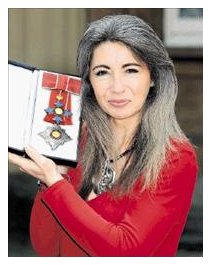 Evelyn's activities also include lobbying the Government
on political
issues, her consortium with Sir James Galway, Julian Lloyd Webber and
the late Michael Caman successfuly led to the Government providing
£332. million towards music education. Other aspects include
Evelyn
Glennie Images, which supplies photographs from a vast image library of
Evelyn, Evelyn Glennie Jewellery, which is a range of Jewellery
designed in conjunction with Ortak is based on her influences as a solo
percussionist and Evelyn Glennie Merchandise. Evelyn is also an
international motivational speaker to many diverse corporate companies
and events. Evelyn also performs with Orchestras on the Great Highland
Bagpipes. Evelyn's activities also include lobbying the Government
on political
issues, her consortium with Sir James Galway, Julian Lloyd Webber and
the late Michael Caman successfuly led to the Government providing
£332. million towards music education. Other aspects include
Evelyn
Glennie Images, which supplies photographs from a vast image library of
Evelyn, Evelyn Glennie Jewellery, which is a range of Jewellery
designed in conjunction with Ortak is based on her influences as a solo
percussionist and Evelyn Glennie Merchandise. Evelyn is also an
international motivational speaker to many diverse corporate companies
and events. Evelyn also performs with Orchestras on the Great Highland
Bagpipes. After 20 years in the music business she has begun teaching privately, which allows her to explore the art of teaching and to explore the world of sound therapy as a means of communication. In 1993 Evelyn was awarded the OBE (Officer of the British Empire). This was extended in 2007 to 'Dame Commander' for her services to music [photo at right], and to date has received over 80 international awards. Please visit Evelyn's website at www.evelyn.co.uk |
Photo
credits from top to bottom -
1st of
Evelyn with cymbal - Sabian©
2nd - with
marimba - Evelyn Glennie Images©/James Wilson
3rd - with
drumkit - unknown
4th -
sitting - Mark Harrison/Good Housekeeping
5th - in
front of wall - from the film Touch the Sound
6th - with
marimba - from the film Touch the Sound
7th -
crouching - Evelyn Glennie Images©/James Wilson
This interview was recorded on February 21,
1994. Portions were used (along with recordings) on WNIB in
1995
and again in 2000; on WNUR in
2006; and also on Contemporary
Classical
Internet Radio
in 2006. A copy of the audio interview was placed in the Archive
of Contemporary Music at Northwestern University. This
transcription was made in 2008 and was posted on this
website that September, and was also placed in the Oral History American Music Archive
of Yale
University.
To see a full list (with links) of interviews which have been transcribed and posted on this website, click here.
Award - winning broadcaster Bruce Duffie was with WNIB, Classical 97 in Chicago from 1975 until its final moment as a classical station in February of 2001. His interviews have also appeared in various magazines and journals since 1980, and he now continues his broadcast series on WNUR-FM, as well as on Contemporary Classical Internet Radio.
You are invited to visit his website for more information about his work, including selected transcripts of other interviews, plus a full list of his guests. He would also like to call your attention to the photos and information about his grandfather, who was a pioneer in the automotive field more than a century ago. You may also send him E-Mail with comments, questions and suggestions.